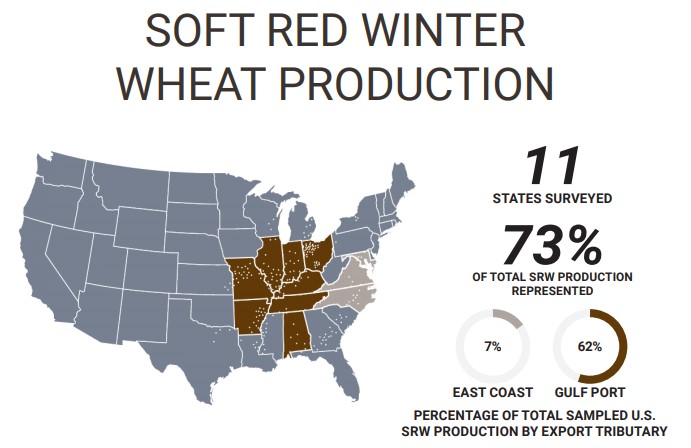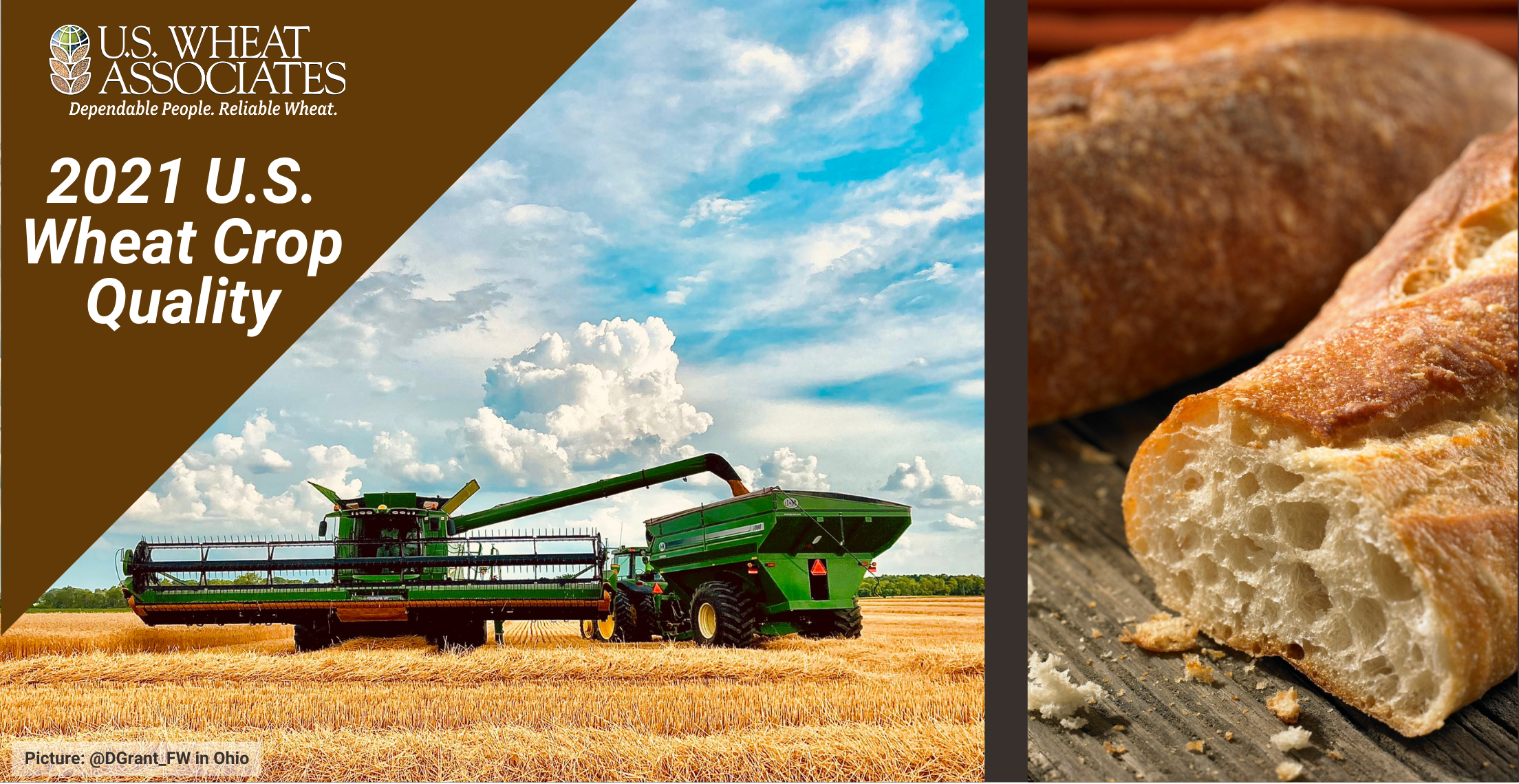As they did in 2020, U.S. wheat farmers have produced an excellent 2021 soft red winter wheat crop for the world’s weak gluten wheat buyers and food processors.
Analysis of 263 samples from elevators in 18 reporting areas across 11 states that account for an estimated 73% of total U.S. SRW production indicates the crop delivers very good performance characteristics. This year’s composite characteristics demonstrate uniformly excellent kernel characteristics, benefited by timely mild temperatures and rainfall.
Other quality factors include less extensibility than in 2020 and the 5-year average, and excellent quality for cookies and crackers. There were pockets of higher enzymatic activity resulting in lower falling numbers and higher damaged starch from the East Coast and isolated portions of the Gulf Ports region, but overall, buyers should be extremely happy with the quality of the entire 2021 SRW crop. Buyers are encouraged to review their quality specifications to ensure that purchases meet their expectations.
U.S. Wheat Associates (USW) has posted the full Soft Red Winter Wheat 2021 Quality Survey on its website here.
Planting and Harvest
USDA estimates the 2021 soft red winter wheat crop seeded area at 6.59 million acres (2.67 million hectares), up from 5.63 million acres (2.28 million hectares) seeded for the 2020 harvest and up from the five-year average. Good growing conditions were overall can be seen in the excellent quality of this crop. Although harvest started slowly with cool, wet conditions, a warm-up helped growers finish in line with the 5-year average. U.S. soft red winter (SRW) wheat production, estimated at 362 million bushels or 9.85 million metric tons (MMT), a 37% increase over 2020 and a 28% increase over the 5-year average.
Samples were collected and analyzed by Great Plains Analytical Laboratory, Kansas City, Mo. The results were weighted by the estimated production for each reporting area and combined into “Composite Average,” “East Coast” and “Gulf Port” values.
2021 Crop Highlights
- Grade – the overall average for the 2021 SRW harvest survey is U.S. No. 2 SRW.
- Test Weight averages are indicative of sound wheat and a uniform crop with Composite 59.7 lb/bu (78.6 kg/hl), Gulf average 60.0 lb/bu (79.8 kg/hl), and East Coast 58.8 lb/bu (77.4 kg/hl).
- 1000 Kernel Weight, Kernel Diameter and Wheat Protein values reflect a relatively uniform crop.
- Wheat Protein content demonstrates a uniform crop. The Composite average of 9.3% (12% mb) and Gulf Ports average of 9.2% are lower than the 5-year averages. The East Coast average of 9.5% is slightly higher than 2020 but below the 5-year average.
- Wheat Falling Number trended lower this year due to localized rainfall during harvest with Composite (297 sec), East Coast (257 sec) and Gulf Ports (307 sec) all below 2020 and 5-year averages. USW Regional Technical Director Peter Lloyd said while low falling number values are not eliminated from the survey, “the very few problem areas resulting from late rains will most likely never come to market.” Buyers will have no problems when they use a minimum 250 second falling number in their specifications.
- Vomitoxin (DON) averages are well below the USDA threshold of 2.0 ppm with Composite at 0.8 ppm, Gulf Ports 0.9 ppm and East Coast 0.2 ppm. “DON levels are among the lowest we have seen in some time,” Lloyd said.
- Laboratory Mill Flour Extraction for Composite (65.9%), East Coast (65.4%) and Gulf Ports (66.1%) are below 2020 and the 5-year averages but still indicate a good milling crop.
- Damaged Starch values are slightly higher this year and can be attributed to higher enzymatic activity in isolated areas.
- Amylograph averages indicate relatively high levels of amylase activity in portions of the crop with low falling numbers. Averages for Composite (440 BU), East Coast (290 BU) and Gulf (477 BU) are lower than last year and 5-year averages.
- Solvent Retention capacity values generally indicate excellent quality for cookies and crackers. Lactic Acid values are above 100 and below 120, indicating excellent quality for crackers
- Dough Properties suggest that this crop has similar protein qualities to last year but weaker than the 5-year average.
- Alveograph L averages for Composite, East Coast and Gulf are 56 mm, significantly lower than 2020 and 5-year average values and indicate low extensibility.
- Average Loaf Volumes are lower than last year and 5-year averages.
- The Cookie Spread Ratios for Composite (10.6), East Coast (10.8) and Gulf (10.5) are all higher than last year and 5-year averages, indicating good spreadability.
[av_hr class=’default’ icon_select=’yes’ icon=’ue808′ font=’entypo-fontello’ position=’center’ shadow=’no-shadow’ height=’50’ custom_border=’av-border-thin’ custom_width=’50px’ custom_margin_top=’30px’ custom_margin_bottom=’30px’ custom_border_color=” custom_icon_color=” id=” custom_class=” template_class=” av_uid=” sc_version=’1.0′ admin_preview_bg=”]
2021 Crop Quality Data on Other U.S. Wheat Classes
Hard Red Spring
Soft White
Hard Red Winter
Northern Durum
Desert Durum® And California Hard Red Winter
Hard White


